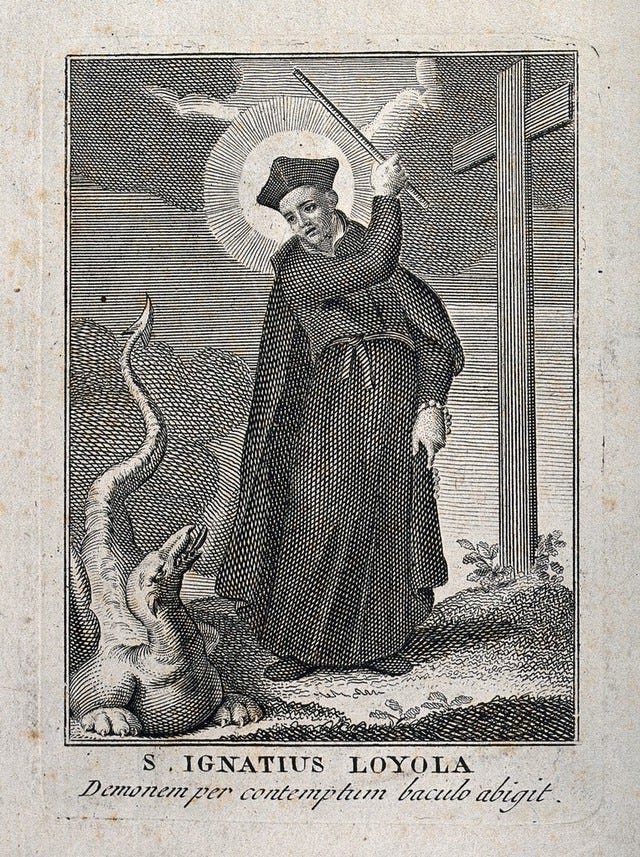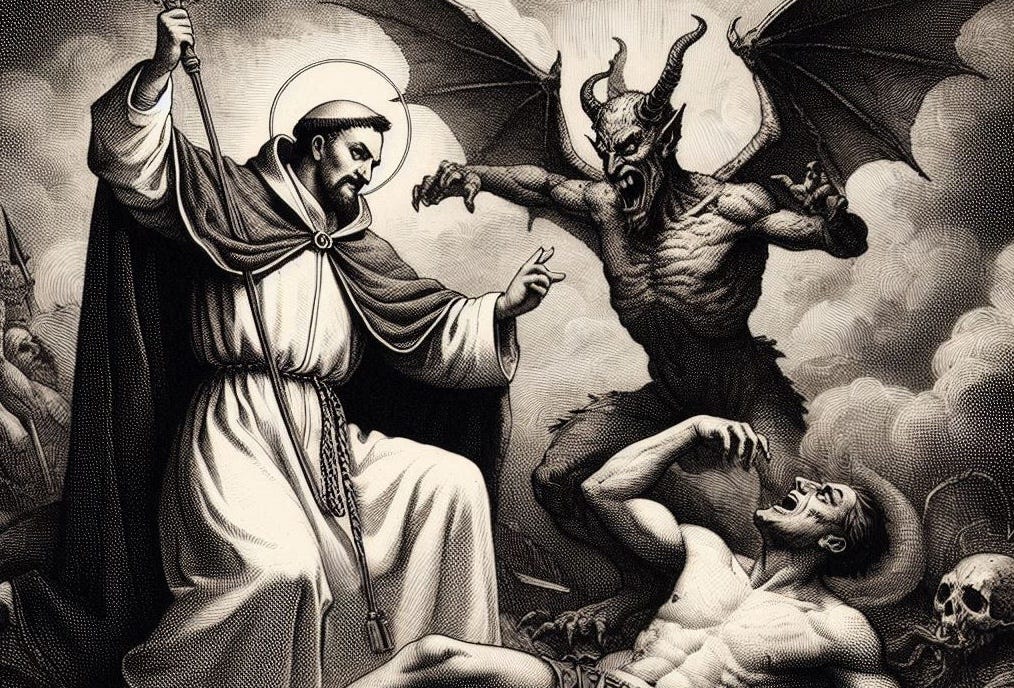
In the Église des Jésuites of Molsheim in Northern France there was curious relic described as late as the 17th century. Within the soaring grandeur of the Gothic cathedral is found the Baroque chapel of St. Ignatius of Loyola which, among other items, housed two scraps of paper written in Greek. The story behind them was investigated on the order of Pope Paul V and inscribed in the chapel walls, and is related at length in Bartoli’s Della vita e dell'istituto di s. Ignatio, fondatore della Compagnia di Gesù.
Michael Ludwig was a young nobleman sent by his father to the court of Lorraine. Like so many before him, Michael fell into dissolute ways and developed a mania for gambling, along with the bad luck that usually accompanies such behavior. With everything lost to him, he swore he would give himself to a demon for some money, whereupon a handsome youth attired like himself appeared at his side. Something about him made Michael shudder, and he knew this was a demon. The young man offered him a handful of money and requested to meet him at the same spot on the next day. Michael returned to the card table and won back his losses and the money of everyone else as well.
The following day Michael returned to the demon, who demanded as payment four drops of blood. It made a painless incision in his arm, then collected the blood in an acorn-cup and ordered Michael to write what he dictated on two scraps of paper. In his Vita, Bartoli identified the letters as mostly Greek, but noted that they made no meaningful words. One of the papers was rolled up tightly and inserted into Michael’s wound, which was then closed, leaving a scar. The other was kept by the demon.
"In virtue of this,” said the demon, “I agree to do all that you command, and to give you all that you ask from me, for the space of seven years; at the end of which time you shall belong to me. Art thou content?"
Michael was not content, but in his despair he knew not what else to do, and said nothing.
The next morning, and every day thereafter, the tempter returned to Michael. He persuaded him to stop the religious devotions he had practiced each day, and began to teach him terrible secrets and depraved new pleasures.
This continued for six years as Michael continued his decline into a dark and sinful life. It was at this point, dreading the approach of the seventh year, that his father called him home. Expecting a young man of refined sensibilities developed at court, he found instead a lost soul leading a rough and vicious life. With only months remaining on his contract with the demon, Michael began to descend into madness, urged on to greater depravities by his demon. He poisoned his parents and set fire to their castle, but God made them immune to the poison and doused the fire.
Michael put a gun to his head and pulled the trigger, but it failed to fire. His sisters prevented another attempt at suicide, but he told them it was no use, and thus his family learned the entire story. His brother, who was in holy orders, bound Michael tightly and took him to Molsheim, where he was put into the hands of the Jesuits.
The Fathers at Molsheim prayed for the assistance of St. Ignatius, who had already wrought great miracles in their church, particular with exorcism. The demon increased his attacks on the young man, appearing in the form of a lion and other wild animals which Michael alone could see, although the horrific howls could be heard by everyone. At one point, it took hold of him and bent him backwards until his spine almost snapped.
The priests began their efforts to free him with Spiritual Exercises, which would prepare him for a general confession. His state was such that the mere sight of the Jesuits filled him with terror. At one point a creature covered in thick hair and with a savage mein appeared and ordered the man to forge a new version of his pact in order to deceive the priests into believing it had been abandoned, but a servant witnessed and exposed the deception. The priests continued to lead him through the exercises with much prayer, fasting, and sprinkling of holy water.
At last the priests set a date for the exorcism on the twelfth of October, 1603. They offered a votive mass of St. Ignatius, where Ludwig professed his faith, renounced the devil, and then received the Eucharist. At that moment, he cried out in horror that two he-goats stood on their hind legs on either side of him, each holding one of the oaths he had written between their forepaws. The priests began the rite of exorcism and invoked the name of Ignatius, and at once the goats fled, and one of the papers fluttered to the ground from his now-open wound, which then closed leaving barely a mark.
That left one of the compacts yet to be recovered, so the priests continued their rites of exorcism. As they once again invoked the name of St. Ignatius, a huge and horribly deformed stork appeared to all and dropped the second paper from its beak, then vanished. The papers were sought on the floor but could not be found. Only later were they discovered on the altar, next to a renunciation of the devil written by Michael Ludwig.
“Thus delivered from his horrible compact with the evil spirit, and from the suffering and agony consequent thereupon, freed from the dreadful temptations which hurried him to crime, and reconciled to God and the Church, the young Ludwig ever after led a holy and Christian life, never forgetting the obligations he was under to the Saint through whose intercession he had obtained his deliverance.” Fr. Daniello Bartoli, SJ, 1650
Author’s Note: Pope Paul V ordered an investigation into the incident of Michael Ludwig’s demon. Adam Petz, Suffragan Bishop of Strasburg, and George, Abbot of Altorf, were interrogated under oath and affirmed the events of Molsheim, attributing the deliverance to God through intervention of St Ignatius.




